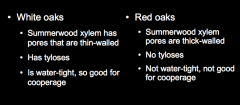![]()
![]()
![]()
Use LEFT and RIGHT arrow keys to navigate between flashcards;
Use UP and DOWN arrow keys to flip the card;
H to show hint;
A reads text to speech;
60 Cards in this Set
- Front
- Back
|
OHF climate |
|
|
|
OHF topography |
gently rolling hills and valleys...not flat but no big elevational changes |
|
|
OHF disturbance |
fire is not major determinant of vegetation, but in past, humans used fire to change vegetation |
|
|
OHF forest vegetation |
- post oak, eastern redcedar on drier sites |
|
|
tulip-poplar: most important |
|
|
|
tulip-poplar: reproduction |
|
|
|
tulip-poplar: uses |
|
|
|
oriented strand board (OSB) |
|
|
|
sweetgum: most important |
|
|
|
sweetgum: reproduction |
|
|
|
sweetgum: uses |
|
|
|
American sycamore: scientific name |
Platanus occidentalis |
|
|
American sycamore: most important |
|
|
|
American sycamore: reproduction |
|
|
|
American sycamore: uses |
|
|
|
shortleaf pine: most important |
|
|
|
shortleaf pine: reproduction |
|
|
|
shortleaf pine: pests/problems |
|
|
|
loblolly pine: most important |
|
|
|
loblolly pine: reproduction |
|
|
|
loblolly pine: pests/problems |
|
|
|
loblolly pine: uses |
most important commercial tree in SE, with vast acreages planted annually
|
|
|
the oaks: genus Quercus |
in Med. area, cork production from cork oak is huge industry wildlife habitat: mast is critical to many species (mast = fruit of forest trees)
|
|
|
two subgenera of North American Quercus |
|
|
|
white oak subgenus |
Leucobalanus (e.g. Quercus alba) |
|
|
red oak subgenus |
Erythrobalanus (e.g. Quercus rubra) |
|
|
white oaks vs. red oaks: leaf differences |
|
|
|
white oaks vs. red oaks: wood differences |

|
|
|
white oaks vs. red oaks: tylosis |
white oaks have them while red oaks do not |
|
|
tylosis |
|
|
|
white oaks vs. red oaks: fruit differences |

|
|
|
some white oaks of OHF |
|
|
|
white oak: most important |
|
|
|
Oglethorpe oak: most important |
|
|
|
red oaks of the OHF loosely follow a site gradient from _______ to ______ to ________ |
wet (hydric) to medium (mesic) to dry (xeric) |
|
|
red oaks of the OHF |
|
|
|
cherrybark oak: scientific name |
Quercus pagoda (Q. falcata var. pagodaefolia) |
|
|
cherrybark oak: most important |
- leaves of this species concentrate salicylic acid and when they fall, the chemical leaches into the soil and inhibits growth of competing plants
|
|
|
water oak: most important |
|
|
|
scarlet oak: most important |
|
|
|
blackjack oak: most important |
|
|
|
hickories of the OHF |
|
|
|
hickories of the OHF are divided into two subgenera... |
|
|
|
differences between Eucarya and Apocarya |

|
|
|
Eucarya species of OHF |
|
|
|
mockernut hickory: most important |
|
|
|
shagbark hickory: sci. name |
Carya ovata |
|
|
shagbark hickory: most important |
|
|
|
Apocarya species of OHF |
|
|
|
bitternut hickory: sci. name |
Carya cordiformis |
|
|
bitternut hickory: most important |
|
|
|
blackgum: most important |
- some pulp - interlocked grain makes it difficult to split for firewood - ornamental due to deep scarlet fall color |
|
|
common persimmon: most important |
|
|
|
sourwood: most important |
|
|
|
sourwood: reproduction |
|
|
|
river birch: most important |
|
|
|
river birch: reproduction |
|
|
|
honeylocust: most important |
|
|
|
honeylocust: reproduction |
|
|
|
honeylocust: uses |
|

